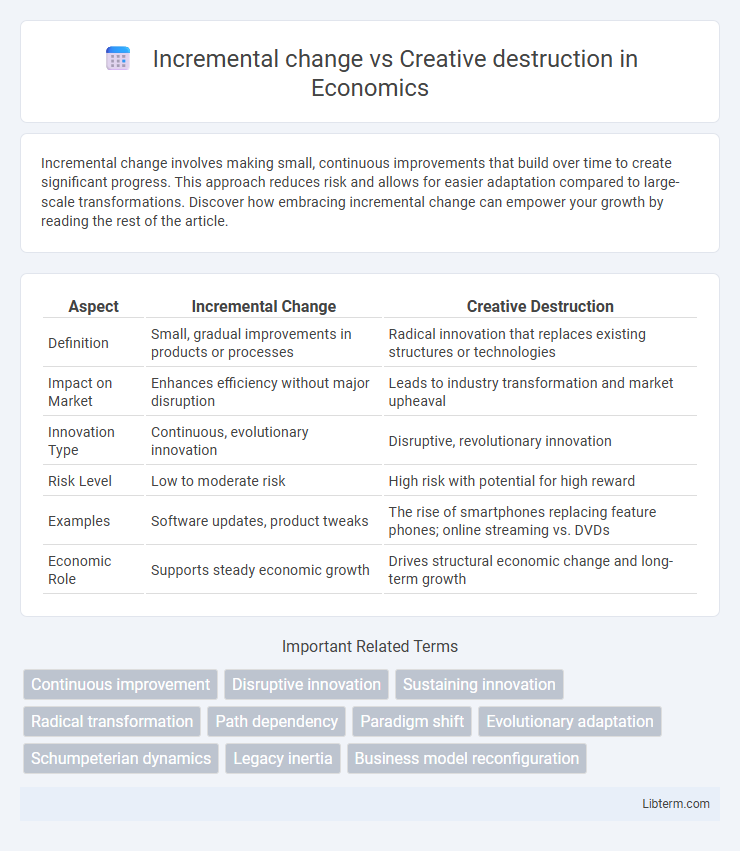Incremental change involves making small, continuous improvements that build over time to create significant progress. This approach reduces risk and allows for easier adaptation compared to large-scale transformations. Discover how embracing incremental change can empower your growth by reading the rest of the article.
Table of Comparison
| Aspect | Incremental Change | Creative Destruction |
|---|---|---|
| Definition | Small, gradual improvements in products or processes | Radical innovation that replaces existing structures or technologies |
| Impact on Market | Enhances efficiency without major disruption | Leads to industry transformation and market upheaval |
| Innovation Type | Continuous, evolutionary innovation | Disruptive, revolutionary innovation |
| Risk Level | Low to moderate risk | High risk with potential for high reward |
| Examples | Software updates, product tweaks | The rise of smartphones replacing feature phones; online streaming vs. DVDs |
| Economic Role | Supports steady economic growth | Drives structural economic change and long-term growth |
Understanding Incremental Change
Incremental change involves small, continuous improvements within existing structures, processes, or products, fostering steady growth and adaptation over time. This approach minimizes risk by building on established knowledge and resources, enabling organizations to refine efficiencies and respond gradually to market demands. Understanding incremental change is essential for sustaining long-term competitive advantage through consistent innovation without disrupting core operations.
Defining Creative Destruction
Creative destruction refers to the process where innovative technologies or business models replace outdated ones, driving economic evolution and industry transformation. This concept highlights disruptive innovation that fundamentally alters market structures by rendering previous products or services obsolete. Unlike incremental change, which involves gradual improvements, creative destruction sparks radical shifts that redefine competitive landscapes and stimulate long-term growth.
Historical Context: Evolution of Change Paradigms
Incremental change reflects the historical paradigm of gradual improvements seen in early industrial revolutions, emphasizing continuous refinement of existing technologies and processes. Creative destruction, a concept popularized by Joseph Schumpeter in the 20th century, represents a radical shift where old industries are dismantled to make way for innovative breakthroughs, marking significant economic transformation. This evolution from incremental adjustments to disruptive innovation underscores the changing nature of economic growth and technological progress throughout history.
Key Differences Between Incremental Change and Creative Destruction
Incremental change involves gradual improvements and continuous development within existing frameworks, enhancing efficiency and stability over time. Creative destruction refers to the process where new innovations disrupt and replace prevailing technologies or business models, leading to significant transformation and industry redefinition. Key differences lie in the scale and impact of change: incremental change builds on current structures, while creative destruction dismantles and redefines them fundamentally.
Advantages of Incremental Change
Incremental change offers advantages such as reduced risk and continuous improvement by allowing organizations to adapt gradually without disrupting existing operations. This approach promotes sustained growth through small, manageable innovations that build on current strengths and resources. Incremental change also facilitates employee acceptance and smoother implementation compared to the radical shifts associated with creative destruction.
Benefits and Risks of Creative Destruction
Creative destruction drives economic growth by replacing outdated products and services with innovative solutions, fostering increased productivity and market efficiency. This process generates substantial benefits such as technological advancement and new job creation in emerging industries while reallocating resources toward more competitive sectors. However, creative destruction poses risks including short-term unemployment, market disruptions, and potential loss of established businesses, requiring adaptive policies to mitigate social and economic instability.
Industry Examples: Incremental vs. Disruptive Innovation
Incremental change in the automotive industry is exemplified by continuous improvements in fuel efficiency and safety features by established manufacturers like Toyota and Ford. In contrast, creative destruction is highlighted by Tesla's disruptive innovation, which redefined the market through electric vehicles and autonomous driving technology, challenging traditional automotive giants. Similarly, in the technology sector, Apple's iterative updates to the iPhone showcase incremental innovation, while the rise of Netflix disrupting traditional cable TV illustrates creative destruction through digital streaming.
When to Choose Incremental Change over Creative Destruction
Incremental change is preferable when an organization operates in a stable environment with predictable customer needs and seeks to enhance existing products or processes without significant risk. This approach supports continuous improvement, cost-efficiency, and employee engagement by building on existing strengths and minimizing disruption. Creative destruction is better suited for industries facing disruptive technologies or market shifts where radical innovation is necessary to survive and thrive.
Impact on Organizational Culture and Structure
Incremental change fosters gradual improvements that reinforce existing organizational culture and preserve hierarchical structures, promoting stability and continuity. Creative destruction drives radical innovation that often disrupts established norms and flattens traditional hierarchies, encouraging adaptability and cultural transformation. Organizations embracing creative destruction tend to develop more agile, flexible cultures, while those favoring incremental change maintain structured, risk-averse environments.
Future Trends: Balancing Growth and Disruption
Incremental change fosters steady growth through continuous improvements in technology, processes, and products, ensuring business stability and customer retention. Creative destruction drives radical innovation by replacing outdated systems with groundbreaking solutions, often disrupting markets and enabling new industries to emerge. Future trends highlight the need for companies to balance incremental advancements with creative destruction to sustain competitive advantage and adapt to evolving consumer demands in rapidly changing markets.
Incremental change Infographic

 libterm.com
libterm.com